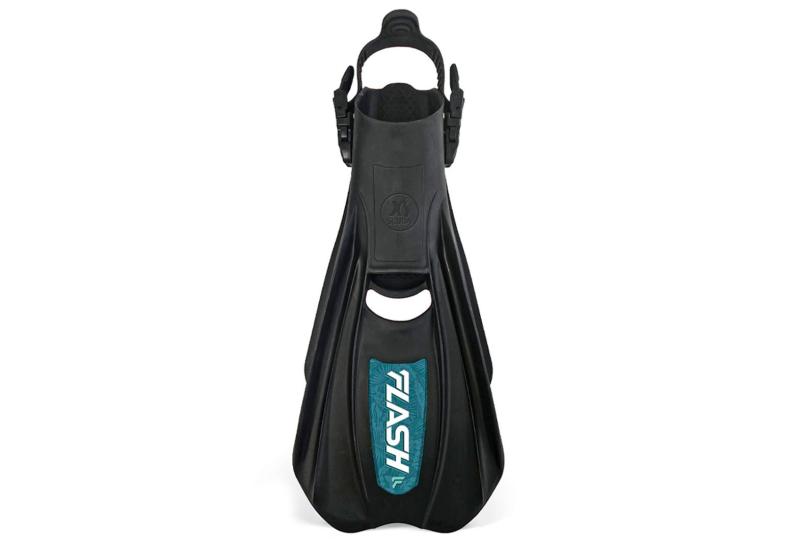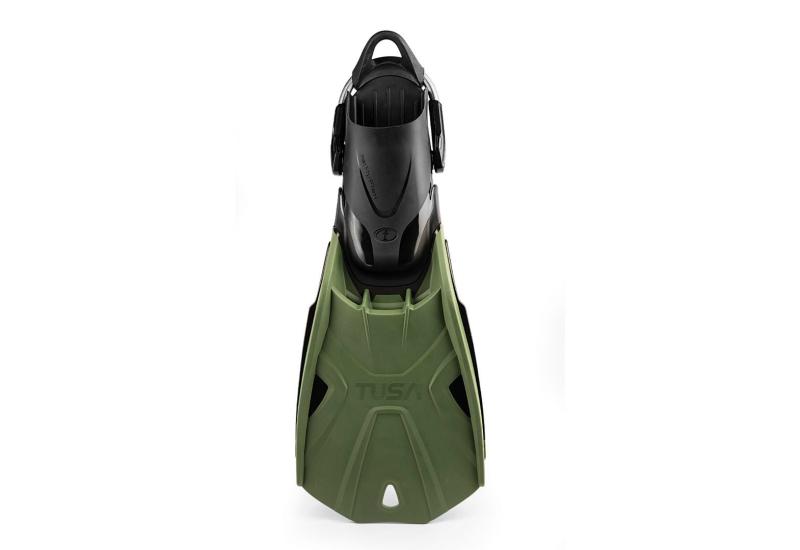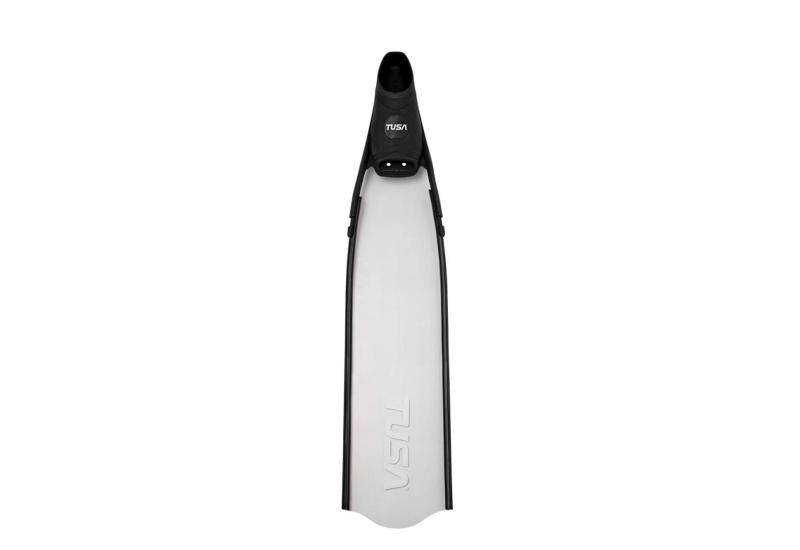2001 Testers' Choice Fins
Speed. If there is one concept to characterize the new millennium we live in, speed is it. Faster internet connections, faster jets, computers, information, and not to be left in the wake, faster fins.
With the advent of Nature's Wing split fin technology last year, fin design took a giant stride forward. The split-fin design allows divers to fin faster and more efficiently--up to 40 percent more efficiently--than conventional paddle fins. Last year, there was only one manufacturer distributing split fins; this year, there are three, with five models and more on the way.
So does that mean the conventional paddle fin is going the way of the paddle wheel? Not at all. The paddle fins in this roundup are the culmination of years of design advances that coax every ounce of efficiency out of this fin technology. And for some divers, paddle fins are still the best way to move forward.
One thing is for sure, the race for faster, more efficient fins is on, and this competition will only benefit divers. This year's Testers' Choice fins, for example, feature more high-performance fins and more Best Buys than ever before.
Of course, speed is not the most important consideration in choosing a fin--efficiency is.
Fins in Review
Apollo Sports Testers' Choice
Apollo Sports Known For: First of the split fins; high performance
Apollo Sports Bio-Fin EX and Pro Bio-Fin
Both split fins received the highest efficiency ratings possible in the last ScubLab fin test. Pro had slightly better scores than the EX. Large open loops on fin straps and swivel buckles make these fins easy on/easy off. Bio-Fin EX, $180; Pro Bio-Fin, $190.
Aqua Lung Testers' Choice
Aqua Lung Known For: Best paddle fin performance, often at budget prices
Aqua Lung Blades
The Blades have tied with the Mares Quattros for the best of the paddle fins in every ScubaLab fin test. After the split fins by Nature's Wing, the Blades produced the best air-consumption rates. $120
Atomic Aquatics Testers' Choice
Atomic Aquatics Known For: High-performance split fins; best buckle system
Atomic Aquatics Splitfin
This fin received outstanding performance scores. It is longer and wider than other split fins with larger than average open-toe foot pockets. Best buckle system available. $189
Genesis Scuba Testers' Choice
Genesis Scuba Known For: Flexibility; modestly priced paddle fin
Genesis Scuba Aquaflex
Sizing, fit and comfort, and the ability to change direction were all rated outstanding. This narrow and flexible paddle fin provides excellent power. Best Buy. $95
International Divers Inc. Testers' Choice
IDI Known For: Good performance at budget price
International Divers Inc. Frog Foot and Power Fin
The Frog Foot's scores for sizing, fit and comfort; changing speeds; different kicks; stability and power vs. stress were all outstanding. While the Frog Foot is long and flexible, the Power Fin is a short vented fin that has most of the same outstanding scores as the Frog Foot, plus top ratings in surface swimming and ability to change direction. Best Buys. Frog Foot, $85; Power Fin, $65.
Mares Testers' Choice
Mares Known For: Most powerful paddle fins; outstanding buckles
Mares Plana Avanti Quattro
Tied with Aqua Lung Blades as the best paddle fin performers in test after test. Best scores of any fin in changing direction and different kicks. Outstanding buckle/strap system. $139
Ocean Reef Best Buy
Oceean Reef Known For: Good performance at outstanding price
Ocean Reef X-Press
The Rapid Release Buckle System makes adjustment and removal easy. Though it scored good to excellent across the board, the best thing about the X-Press is the price. Only two sizes. Best Buy. $50
Scubapro Testers' Choice
Scubapro Known For: High performance split fins with wide distribution
Scubapro Jet Fin
Top scores in sizing, fit and comfort; surface swimming, changing speed, changing direction; different kicks and stability. Overall performance is nearly identical to the IDI Power Fin, which is a copy of the original Scubapro Jet Fin. Best Buy. $100
Scubapro Twin Jet and Twin Jet Graphite
Both Twin Jet fins are open-toed and vented split fins. The black Twin Jets are negatively buoyant, while the gray-colored Twin Jet Graphites are positively buoyant and slightly more flexible. Like the Apollo and Atomic Aquatics split fins, performance scores are outstanding. Extended heel platform. $189
Fins and Speed
As experienced divers realize, speed is not a priority of underwater swimming; increasing your speed costs you dearly in energy and air consumption. To double your speed, you have to at least quadruple your effort.
Based on our testing, divers using full scuba equipment in the ocean can only sustain top speeds of 1 to 2 mph. We have tested fins that barely allowed divers to reach 1 mph, while, at the other end of the scale, the best course runs we have ever recorded were well over 3 mph, by a top athlete using the most efficient fins. But most of us will max out at 1 to 2 mph with good fins. And it takes excellent respiratory and circulatory fitness, strong muscles and well-designed fins to sustain top speeds for more than a few minutes.
Most good paddle fins will peak out at 1.5 to 1.9 mph, with a very few, such as Mares Quattros, reaching speeds in the 2 to 2.5 mph range. The newer propeller fins also peak out in the range of 2 to 2.5 mph, but they allow the diver to sustain these higher speeds for longer periods of time.
When Are Splitfins Not the Best?
Despite being the most efficient fin design available, split-fin technology is not the best choice for all conditions. The flat, solid, ungiving blade of paddle fins can execute sudden turns, extremely short bursts of speed and some kicks, such as the frog or scissors, better than split fins. Although you can do these alternate kicks wearing split fins, you'll have to adapt the kicks somewhat. For most divers, these limitations will never be noticed, but for deep wreck or cave divers, they may be more noticeable. In overhead environments, where tech divers depend on alternative kicks to avoid disturbing the silty floor, conventional paddle fin technology may have an advantage.
Speed. If there is one concept to characterize the new millennium we live in, speed is it. Faster internet connections, faster jets, computers, information, and not to be left in the wake, faster fins.
With the advent of Nature's Wing split fin technology last year, fin design took a giant stride forward. The split-fin design allows divers to fin faster and more efficiently--up to 40 percent more efficiently--than conventional paddle fins. Last year, there was only one manufacturer distributing split fins; this year, there are three, with five models and more on the way.
So does that mean the conventional paddle fin is going the way of the paddle wheel? Not at all. The paddle fins in this roundup are the culmination of years of design advances that coax every ounce of efficiency out of this fin technology. And for some divers, paddle fins are still the best way to move forward.
One thing is for sure, the race for faster, more efficient fins is on, and this competition will only benefit divers. This year's Testers' Choice fins, for example, feature more high-performance fins and more Best Buys than ever before.
Of course, speed is not the most important consideration in choosing a fin--efficiency is.
Fins in Review
Apollo Sports Testers' Choice
Apollo Sports Known For: First of the split fins; high performance
Apollo Sports Bio-Fin EX and Pro Bio-Fin
Both split fins received the highest efficiency ratings possible in the last ScubLab fin test. Pro had slightly better scores than the EX. Large open loops on fin straps and swivel buckles make these fins easy on/easy off. Bio-Fin EX, $180; Pro Bio-Fin, $190.
Aqua Lung Testers' Choice
Aqua Lung Known For: Best paddle fin performance, often at budget prices
Aqua Lung Blades
The Blades have tied with the Mares Quattros for the best of the paddle fins in every ScubaLab fin test. After the split fins by Nature's Wing, the Blades produced the best air-consumption rates. $120
Atomic Aquatics Testers' Choice
Atomic Aquatics Known For: High-performance split fins; best buckle system
Atomic Aquatics Splitfin
This fin received outstanding performance scores. It is longer and wider than other split fins with larger than average open-toe foot pockets. Best buckle system available. $189
Genesis Scuba Testers' Choice
Genesis Scuba Known For: Flexibility; modestly priced paddle fin
Genesis Scuba Aquaflex
Sizing, fit and comfort, and the ability to change direction were all rated outstanding. This narrow and flexible paddle fin provides excellent power. Best Buy. $95
International Divers Inc. Testers' Choice
IDI Known For: Good performance at budget price
International Divers Inc. Frog Foot and Power Fin
The Frog Foot's scores for sizing, fit and comfort; changing speeds; different kicks; stability and power vs. stress were all outstanding. While the Frog Foot is long and flexible, the Power Fin is a short vented fin that has most of the same outstanding scores as the Frog Foot, plus top ratings in surface swimming and ability to change direction. Best Buys. Frog Foot, $85; Power Fin, $65.
Mares Testers' Choice
Mares Known For: Most powerful paddle fins; outstanding buckles
Mares Plana Avanti Quattro
Tied with Aqua Lung Blades as the best paddle fin performers in test after test. Best scores of any fin in changing direction and different kicks. Outstanding buckle/strap system. $139
Ocean Reef Best Buy
Oceean Reef Known For: Good performance at outstanding price
Ocean Reef X-Press
The Rapid Release Buckle System makes adjustment and removal easy. Though it scored good to excellent across the board, the best thing about the X-Press is the price. Only two sizes. Best Buy. $50
Scubapro Testers' Choice
Scubapro Known For: High performance split fins with wide distribution
Scubapro Jet Fin
Top scores in sizing, fit and comfort; surface swimming, changing speed, changing direction; different kicks and stability. Overall performance is nearly identical to the IDI Power Fin, which is a copy of the original Scubapro Jet Fin. Best Buy. $100
Scubapro Twin Jet and Twin Jet Graphite
Both Twin Jet fins are open-toed and vented split fins. The black Twin Jets are negatively buoyant, while the gray-colored Twin Jet Graphites are positively buoyant and slightly more flexible. Like the Apollo and Atomic Aquatics split fins, performance scores are outstanding. Extended heel platform. $189
Fins and Speed
As experienced divers realize, speed is not a priority of underwater swimming; increasing your speed costs you dearly in energy and air consumption. To double your speed, you have to at least quadruple your effort.
Based on our testing, divers using full scuba equipment in the ocean can only sustain top speeds of 1 to 2 mph. We have tested fins that barely allowed divers to reach 1 mph, while, at the other end of the scale, the best course runs we have ever recorded were well over 3 mph, by a top athlete using the most efficient fins. But most of us will max out at 1 to 2 mph with good fins. And it takes excellent respiratory and circulatory fitness, strong muscles and well-designed fins to sustain top speeds for more than a few minutes.
Most good paddle fins will peak out at 1.5 to 1.9 mph, with a very few, such as Mares Quattros, reaching speeds in the 2 to 2.5 mph range. The newer propeller fins also peak out in the range of 2 to 2.5 mph, but they allow the diver to sustain these higher speeds for longer periods of time.
When Are Splitfins Not the Best?
Despite being the most efficient fin design available, split-fin technology is not the best choice for all conditions. The flat, solid, ungiving blade of paddle fins can execute sudden turns, extremely short bursts of speed and some kicks, such as the frog or scissors, better than split fins. Although you can do these alternate kicks wearing split fins, you'll have to adapt the kicks somewhat. For most divers, these limitations will never be noticed, but for deep wreck or cave divers, they may be more noticeable. In overhead environments, where tech divers depend on alternative kicks to avoid disturbing the silty floor, conventional paddle fin technology may have an advantage.









